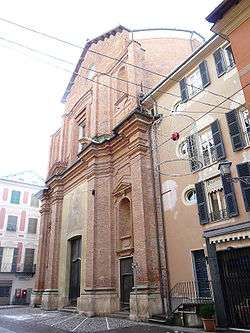Novi Ligure
| Novi Ligure | ||
|---|---|---|
| Comune | ||
| Città di Novi Ligure | ||
|
Palazzo Delle Piane. | ||
| ||
 Novi Ligure Location of Novi Ligure in Italy | ||
| Coordinates: IT 44°45′42″N 08°47′26″E / 44.76167°N 8.79056°ECoordinates: IT 44°45′42″N 08°47′26″E / 44.76167°N 8.79056°E | ||
| Country | Italy | |
| Region | Piedmont | |
| Province / Metropolitan city | Alessandria (AL) | |
| Frazioni | Barbellotta, Merella | |
| Government | ||
| • Mayor | Lorenzo Robbiano | |
| Area | ||
| • Total | 54.22 km2 (20.93 sq mi) | |
| Elevation | 197 m (646 ft) | |
| Population (31 December 2008)[1] | ||
| • Total | 28,581 | |
| • Density | 530/km2 (1,400/sq mi) | |
| Demonym(s) | Novesi | |
| Time zone | CET (UTC+1) | |
| • Summer (DST) | CEST (UTC+2) | |
| Postal code | 15067 | |
| Dialing code | 0143 | |
| Patron saint | Madonna of the Snow | |
| Saint day | August 5 | |
| Website | Official website | |

Novi Ligure (Nêuve in Ligurian) is a city and comune north of Genoa, in the Piedmont region of the province of Alessandria of northwest Italy.
The town produces food, iron, steel, and textiles. It is an important junction for both road and railroad.
History
The community of Curtis Nova in 970 was donated by Emperor Otto I to the monastery of St. Salvatore in Pavia, becoming a castle around the year 1000.
Novi was a free commune until 1157, when it fell to Tortona. It was handed over the marquis of Montferrat in 1223, returning briefly to Tortona in 1232–64. In 1353 Giovanni Visconti of Milan and Genoa conquered it. Novi was donated to the latter in 1392, but was occupied by the condottiero Facino Cane in 1409–12. In 1447, after the death of Filippo Maria Visconti, the governors of the city decided to free forever from Milan, and gave it to Genoa. Around this time, a feudal lord Galeazzo Cavanna was Signore di Castel Gazzo, a fortress on the edge of the town. However, the Sforza of Milan retained its possession until the defeat of Ludovico il Moro, when it passed to the French until Andrea Doria conquered the city for Genoa in 1529.
Novi Ligure remained part of the Republic of Genoa until 1805, with the exception of a brief Austrian-Piedmontese occupation in 1745–46. In 1799 it was the site of a French defeat by an Austro-Russian army, in which the French commander Joubert was killed.
Novi was annexed to the French Empire and, after its fall, to the Kingdom of Sardinia. In 1818 it became provincial capital and received the suffix of "Ligure" to mark the historical vicinity to Genoa in contrast to the annexion of the province to that of Alessandria.
Main sights
In the 17th and 18th centuries Novi Ligure was a renowned resort for the rich Genoese families, as showed by the presence of numerous noble palaces in the historical center of the city, often decorated with frescoes facades. These include Palazzo Negroni, Palazzo Durazzo and others. The most important palace is Palazzo Delle Piane (Delle Piane family), situated in the historic Piazza Delle Piane.
The Pieve of Santa Maria, on the road for Cassano, is the most ancient religious building (12th century). It has a nave with two aisles, and apses from the original edifice. In the interior is a fresco (1474) by Manfredino Boxilio, portraying the then sovereign of Novi, Oriana di Campofregoso and saints.
The Oratory of St. Madeleine houses a massive cavalry composed of 21 wooden statues and two natural-size horses, as well as an 8-statuettes terracotta Complaint of Christ. Both are from Renaissance.
Novi has retained part of its walls, erected in 1447 and partly demolished in the 19th century, together with the tower of the Castle. The subterraneans can be visited in summer.
The Museo dei Campionissimi is a museum devoted to the two famous cyclists Costante Girardengo and Fausto Coppi and the bicycle history in general.
Economy
The most important factory of the town is the group Elah-Dufour that produces Novi chocolate and Big Fruit candies.
The Garlando factory moved into the region in late 2002.
Notable Novesi
- Delle Piane family
- Cavanna family
- Costante Girardengo (1893–1978), professional cyclist.
Sport
The town’s football club are:
Twin towns
 Marignane, France
Marignane, France Sorbiers, France, since 2008
Sorbiers, France, since 2008 Elbasan, Albania, since 2009
Elbasan, Albania, since 2009 Bicester, England, since 2010
Bicester, England, since 2010


